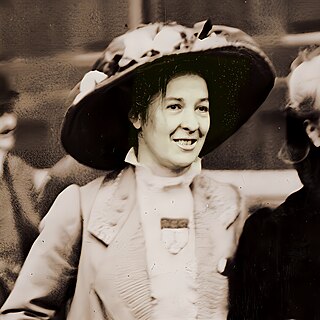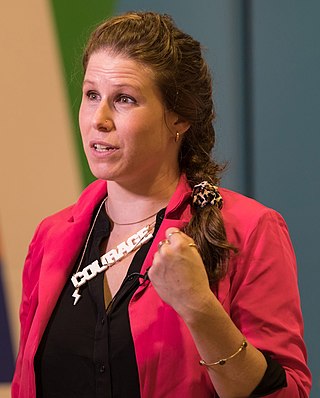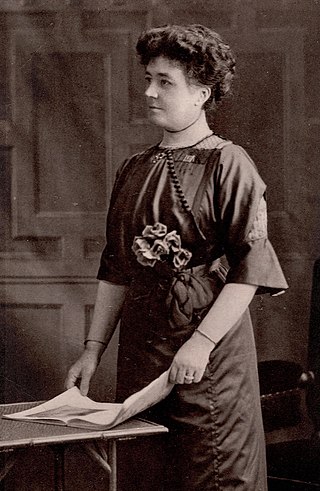
Dame Millicent Garrett Fawcett was an English political activist and writer. She campaigned for women's suffrage by legal change and in 1897–1919 led Britain's largest women's rights association, the National Union of Women's Suffrage Societies (NUWSS), explaining, "I cannot say I became a suffragist. I always was one, from the time I was old enough to think at all about the principles of Representative Government." She tried to broaden women's chances of higher education, as a governor of Bedford College, London and co-founding Newnham College, Cambridge in 1875. In 2018, a century after the Representation of the People Act, she was the first woman honoured by a statue in Parliament Square.

Emmeline Pankhurst was a British political activist who organised the British suffragette movement and helped women win the right to vote. In 1999, Time named her as one of the 100 Most Important People of the 20th Century, stating that "she shaped an idea of objects for our time" and "shook society into a new pattern from which there could be no going back". She was widely criticised for her militant tactics, and historians disagree about their effectiveness, but her work is recognised as a crucial element in achieving women's suffrage in the United Kingdom.

Dame Christabel Harriette Pankhurst was a British suffragette born in Manchester, England. A co-founder of the Women's Social and Political Union (WSPU), she directed its militant actions from exile in France from 1912 to 1913. In 1914, she supported the war against Germany. After the war, she moved to the United States, where she worked as an evangelist for the Second Adventist movement.

Frederick William Pethick-Lawrence, 1st Baron Pethick-Lawrence, PC was a British Labour politician who, among other things, campaigned for women's suffrage.

Adela Constantia Mary Walsh was a British born suffragette who worked as a political organiser for the Women's Social and Political Union (WSPU) in Scotland. In 1914 she moved to Australia where she continued her activism and was co-founder of both the Communist Party of Australia and the Australia First Movement.

Rosa May Billinghurst was a British suffragette and women's rights activist. She was known popularly as the "cripple suffragette" as she campaigned in a tricycle.

Emmeline Pethick-Lawrence, Baroness Pethick-Lawrence was a British women's rights activist and suffragette.

Teresa Billington-Greig was a British suffragette who was one of the founders of the Women's Freedom League in 1907. She had left the Women's Social and Political Union - also known as the WSPU – as she considered the leadership led by Emmeline Pankhurst and her daughters too autocratic. In 1904, she was appointed by the WSPU as a travelling speaker for the organisation. In Autumn 1906, Billington-Greig was tasked with drumming up support for branches of WSPU in Scotland. On 25 April 1906, she unveiled a 'Votes for Women' banner from the Ladies Gallery during the debate in the House of Commons. In June 1906, she was arrested in a fracas outside of Chancellor of the Exchequer H. H. Asquith's home, and as a result was the first suffragette to be incarcerated in Holloway Prison.

Edith How-Martyn was a British suffragette and a member of the Women's Social and Political Union (WSPU). She was arrested in 1906 for attempting to make a speech in the House of Commons. This was one of the first acts of suffragette militancy. She met Margaret Sanger in 1915 and they created a conference in Geneva. How-Martyn toured India talking about birth control. She had no children and died in Australia.

Dorothy Frances Montefiore, known as Dora Montefiore, was an English-Australian women's suffragist, socialist, poet, and autobiographer.

Flora McKinnon Drummond, was a British suffragette. Nicknamed 'The General' for her habit of leading Women's Rights marches wearing a military style uniform 'with an officers cap and epaulettes' and riding on a large horse, Drummond was an organiser for the Women's Social and Political Union (WSPU) and was arrested nine times for her activism in the Women's Suffrage movement. Drummond's main political activity was organising and leading rallies, marches and demonstrations. She was an accomplished orator and had a reputation for being able to put down hecklers with ease.

Mary Eleanor Gawthorpe was an English suffragette, socialist, trade unionist and editor. She was described by Rebecca West as "a merry militant saint".

Ada Nield Chew was a campaigning socialist and a British suffragist. Her name is on the plinth of Millicent Fawcett's statue in Parliament Square, London.

A suffragette was a member of an activist women's organisation in the early 20th century who, under the banner "Votes for Women", fought for the right to vote in public elections in the United Kingdom. The term refers in particular to members of the British Women's Social and Political Union (WSPU), a women-only movement founded in 1903 by Emmeline Pankhurst, which engaged in direct action and civil disobedience. In 1906, a reporter writing in the Daily Mail coined the term suffragette for the WSPU, derived from suffragist, in order to belittle the women advocating women's suffrage. The militants embraced the new name, even adopting it for use as the title of the newspaper published by the WSPU.

Caroline Emma Criado Perez is a British feminist author, journalist and activist. Her first national campaign, the Women's Room project, aimed to increase the presence of female experts in the media. She opposed the removal of the only woman from British banknotes, leading to the Bank of England's swift announcement that the image of Jane Austen would appear on the £10 note by 2017. That campaign led to sustained harassment on the social networking website Twitter of Criado Perez and other women; as a result, Twitter announced plans to improve its complaint procedures. Her most recent campaign was for a sculpture of a woman in Parliament Square; the statue of Millicent Fawcett was unveiled in April 2018, as part of the centenary celebrations of the winning of women's suffrage in the United Kingdom. Her 2019 book Invisible Women: Exposing Data Bias in a World Designed for Men was a Sunday Times bestseller.

The Emmeline and Christabel Pankhurst Memorial is a memorial in London to Emmeline Pankhurst and her daughter Christabel, two of the foremost British suffragettes. It stands at the entrance to Victoria Tower Gardens, south of Victoria Tower at the southwest corner of the Palace of Westminster. Its main feature is a bronze statue of Emmeline Pankhurst by Arthur George Walker, unveiled in 1930. In 1958 the statue was relocated to its current site and the bronze reliefs commemorating Christabel Pankhurst were added.

Julia Scurr was a British politician and suffragette.

Edith Mansell-Moullin was an English suffragist of Welsh heritage and social activist. Proud of her Welsh roots, she founded the Cymric Suffrage Union, which was dedicated to gaining women's suffrage for Welsh women. She was the co-organizer of the Welsh contingent of the 1911 procession of the Women’s Suffrage Union’s "Great Demonstration" held in 1911 in London. Part of the more militant British suffrage contingent, she was imprisoned for dissidence and refused to stop government agitation during World War I.

Lucy Minnie Baldock was a British suffragette. Along with Annie Kenney, she co-founded the first branch in London of the Women's Social and Political Union.

Reverend Claude Hinscliff (1875–1964) was a British suffragist. He was a leading person in the Church League for Women's Suffrage.
























